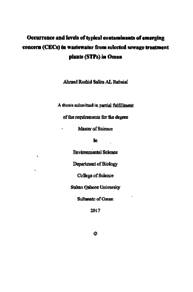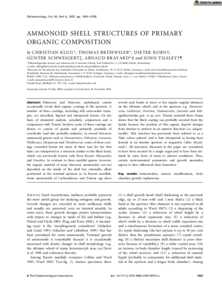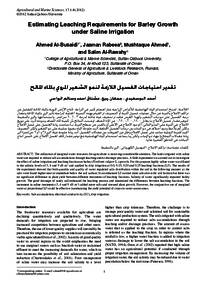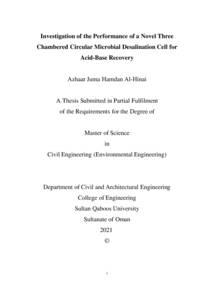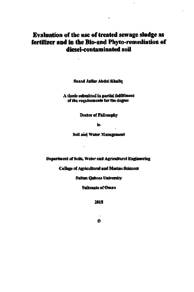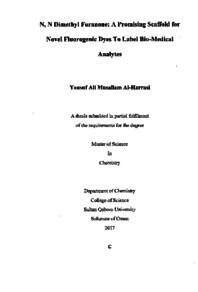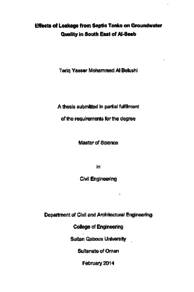Document
Occurrence and levels of typical contaminants of emerging concern (CECs) in wastewater from selected sewage treatment plants (STPs) in Oman
Publisher
Sultan Qaboos University
Gregorian
2017
Language
English
Subject
English abstract
Contaminants of emerging concern (CECs) is a term used to describe unregulated chemicals, including pharmaceuticals and personal care products (PPCPs), present in environmental matrices (mainly water) at very low concentrations. However, they have potential to cause unknown or suspected ecological and public health effects. Recently, they have been considered as issue for many scientific studies due to its frequent detection in various natural waters and wastewaters. They are not regulated by legislation and not included in routine monitoring programs. Here, wastewater samples from three sewage treatment plants (STPs) (old Al Ansab, new Al Ansab and A'Seeb) in Muscat Governorate, Sultanate of Oman were obtained and analyzed for occurrence and levels of diclofenac, caffeine, paracetamol, tetracycline, triclosan, ibuprofen, and sulfamethoxazole using liquid chromatography coupled to tandem mass spectrometry (LC-MS/MS). In addition, correlation between the detected CECs and physicochemical parameters of wastewater samples (conductivity, pH, total organic carbon or TOC and turbidity) were examined. Prior to actual analyses, the solid phase extraction (SPE) using C18 cartridge was assessed using two spiking concentrations (0.1 ppb and 0.5 ppb) of the standard mixture solution containing all the selected CECs. The result showed recoveries for the investigated CECs ranging from 82 to 100%. In wastewater samples from the 3 STPs, all compounds were detected except ibuprofen and sulfametoxazole with detection of sample percentages ranging from 15% (for triclosan) to 65% (for diclofenac). The wide variability in concentrations reported here for the selected CECs were found mainly in wastewater samples obtained before aeration tanks dominantly in old Al Ansab STP, a conventional STP still receiving raw wastewater via tankers. Generally, the detection of the CECs may be influenced by various factors including low levels in wastewater samples, effectiveness of STPs in removal of such contaminants and likely the delayed elution of the compounds retained in the C18 cartridge. While all detected CECs exhibited significant correlations with turbidity, diclofenac and paracetamol were also significantly related to pH and TOC of the wastewater samples. Overall, the study provided quantitative data on presence and levels of typical aforementioned CECs for wastewater samples from Oman.
Member of
Resource URL
Arabic abstract
الملوثات الناشئة (الحديثة) هو مصطلح يصف المركبات الكيميائية غير المتحكم بضبطها في البيئة والتي ظهرت حديثا بما في ذلك المستحضرات الصيدلانية ومستحضرات العناية الشخصية المتواجدة بكميات بسيطة جدا في مكونات البينة وخاصة المياه. وعلى الرغم من ذلك فإنها من الممكن أن تسبب آثارا غير معروفة أو مشتبه بها على البيئة والكائنات الحية. في الآونة الأخيرة, أصبحت هذه المركبات قضية لكثير من الدراسات العلمية بسبب الكشف المتكرر لها في مختلف مصادر المياه الطبيعية ومياه الصرف الصحي. ان الدراسة الحالية قامت بأخذ عينات المياه الصرف الصحي من ثلاثة محطات لتحلية المياه ومعالجة مياه المجاري (محطة الأنصب القديمة, محطة الأنصب الحديثة. محطة السيب في محافظة مسقط في سلطنة عمان وذلك لدراسة وتحليل مستويات تواجد عدد من المركبات وهي الديكلوفينك, الكافيين, الباراسيتامول, التيتراسيكلين, الترايكلوزان, الأيبوبروفين, والسيلفامثاکسوزول من خلال استخدام السائل اللوني الفصل العناصر من مركباتها وجهاز مطياف الكتلة (LC MS- MS ). بالإضافة إلى ذلك, فإن الدراسة قامت بتحليل العلاقة بين هذه المركبات المستهدفة والخصائص الفيزيائية والكيميائية لعينات الصرف الصحي مثل التوصيلية الكهربائية ودرجة الحموضة ومستوى الكربون العضوي الكلي والتعكر. وقامت الدراسة قبل التحليل الفعلي للمركبات باستخراج الطور الصلب لها عن طريق استخدام خرطوشة سي ۱۸( SPE, C18 ) لتقييم استرداد المركبات في الماء عند تركيزين مختلفين (۰٫۱ جزء من البليون و ۰٫5 جزء من البليون) من محلول الخليط القياسي والذي يحتوي على جميع المركبات المختارة. حيث أظهرت النتائج استردادا لجميع المركبات بنسب تتراوح بين ۸۲% الى ۱۰۰% . تم الكشف عن جميع المركبات المذكورة باستثناء الأيبوبروفين والسيلفامثاکسوزول في جميع العينات من محطات المعالجة الثلاث بنسب متفاوتة تراوحت بين ۱۰% لمركب التريكلوزان و ۹۰% المركب الديكلوفينك. ولقد أوضحت الدراسة بان التباين الواسع بين تركيزات المركبات المذكورة كان ظاهرا بشكل واضح قبل مرحلة خزانات التهوية وخاصة في محطة الأنصب القديمة باعتبارها محطة تستخدم التقنية التقليدية والتي يتم فيها نقل مياه الصرف الصحي الخام عن طريق الناقلات. عموما, قد يتأثر الكشف عن مركبات الملوثات الحديثة بعدة عوامل منها المستويات المنخفضة لعينات الصرف الصحي وفاعلية محطة معالجة الصرف الصحي في التخلص من هذه المركبات وكذلك فاعلية البروتوكول المستخدم للتحليل الكيميائي والكمي. وكشفت الدراسة أن جميع المركبات المحللة لها علاقه و ارتباط كبير مع التعكر بينما أظهرت ارتباط مركبين فقط مع درجة الحموضة ومستوی الكربون العضوي الكلي وهما الديكلوفينك والباراسيتامول. وبشكل عام, قدمت الدراسة بيانات كمية عن وجود ومستويات تراكيز المركبات المذكورة في عينات مياه الصرف الصحي في سلطنة عمان.
Category
Theses and Dissertations

